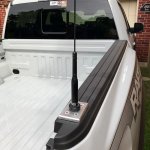- Joined
- Mar 22, 2018
- Messages
- 180
Hello all!
I posted in this section about a year ago seeking advice on a radio installation for a 1995 Dodge Dakota, and I received lots of great advice! However, a wise man in the thread commented that if I wanted to use an equipment console, which is a priority, then I probably should get a newer vehicle... so that is exactly what I did! It was a decision that I thank myself for making for many more reasons than just radio stuff, but radio stuff is important; that's why we're here.
That being said, I finally have some space in my budget deploy my mobile radio setup and I have a lot of it hammered out, but there are some things on which I would still like the community's input.
First some info:
2017 F-150 SuperCrew (Short bed 5.5ft if it matters)
Havis C-VSW-3000-F150-1 is the console of choice
Radios will be:
SDS200 Scanner
Anytone AT-D578UV PRO (Part 90 version) (50w)
Kenwood TK-690H (110w)
(and maybe a CB but only as antenna space permits)
The roof measures ~53" wide x ~66" long so I have a decent amount of room for three antennas but I am still concerned about overloading the front end of the scanner from transmissions from the two transceivers. I have heard about the use of an RF limiter for the scanner but have not been able to find any specific models or part numbers for ones that will work for that amount of power.
Is there a way that would be recommended to space the antennas on the roof to avoid using one but still keep proper ground plane? If not, what limiter should I use and where can I find it? Does a limiter significantly affect the reception of the scanner?
Also, if I wanted to do CB could I reasonably fit such antenna on the roof with the others? Maybe on my one of bed rails if the roof wouldn't be ideal? Not a biggie if I cannot have CB, though it would be nice.
It seems like most makers of NMO mounts use brass for their connectors, which brings up the concern of corrosion occurring on the truck's aluminum body. Are there aluminum mounts or a corrosion prevention technique that can be utilized?
Any additional advice and two-cents is appreciated too,
-CH
I posted in this section about a year ago seeking advice on a radio installation for a 1995 Dodge Dakota, and I received lots of great advice! However, a wise man in the thread commented that if I wanted to use an equipment console, which is a priority, then I probably should get a newer vehicle... so that is exactly what I did! It was a decision that I thank myself for making for many more reasons than just radio stuff, but radio stuff is important; that's why we're here.
That being said, I finally have some space in my budget deploy my mobile radio setup and I have a lot of it hammered out, but there are some things on which I would still like the community's input.
First some info:
2017 F-150 SuperCrew (Short bed 5.5ft if it matters)
Havis C-VSW-3000-F150-1 is the console of choice
Radios will be:
SDS200 Scanner
Anytone AT-D578UV PRO (Part 90 version) (50w)
Kenwood TK-690H (110w)
(and maybe a CB but only as antenna space permits)
The roof measures ~53" wide x ~66" long so I have a decent amount of room for three antennas but I am still concerned about overloading the front end of the scanner from transmissions from the two transceivers. I have heard about the use of an RF limiter for the scanner but have not been able to find any specific models or part numbers for ones that will work for that amount of power.
Is there a way that would be recommended to space the antennas on the roof to avoid using one but still keep proper ground plane? If not, what limiter should I use and where can I find it? Does a limiter significantly affect the reception of the scanner?
Also, if I wanted to do CB could I reasonably fit such antenna on the roof with the others? Maybe on my one of bed rails if the roof wouldn't be ideal? Not a biggie if I cannot have CB, though it would be nice.
It seems like most makers of NMO mounts use brass for their connectors, which brings up the concern of corrosion occurring on the truck's aluminum body. Are there aluminum mounts or a corrosion prevention technique that can be utilized?
Any additional advice and two-cents is appreciated too,
-CH


